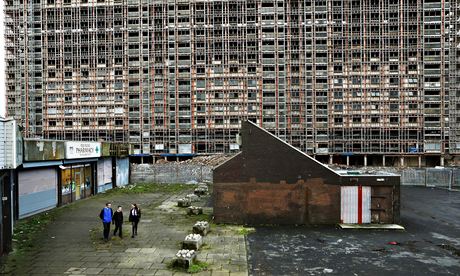Submitted by WA Contents
Demolishing Glasgow’s Red Road flats could leave the city’s reputation in rubble
United Kingdom Architecture News - Apr 13, 2014 - 12:18 6072 views
There are honest arguments in favour of demolishing the Red Road tower blocks, but the idea that this is a 'respectful celebration' that will 'wow the world' is absolute flapdoodle

The misplaced civic grandeur that promoted the building of the Red Road flats now dresses up their demolition, which is a frivolous gimmick, writes Ian Jack. Photograph: Murdo Macleod for the Guardian
In the late 1960s I applied for a job at the BBC in Glasgow and was, as people at the BBC used to say, "boarded", meaning that I went to be interviewed by six or seven executives who sat at a long table facing me rather like the inquisitorial Roundheads in the William Frederick Yeames painting And When Did You Last See Your Father? In fact, the questions were friendly. I remember only two. What novel was I reading? How would I begin a television documentary about present-day Glasgow if I were lucky enough to be asked to make one? The answers came easily enough. Stepping Westward by Malcolm Bradbury in the first instance, and in the second: "Oh, with a wrecking ball bringing down a tenement wall … the falling bricks, the dust, the ball swinging in again … "
It wouldn't have needed the imagination of Eisenstein to come up with that opening shot. We sat in comfortable surroundings, the BBC's then Scottish headquarters in Queen Margaret Drive that had once been a Victorian manufacturer's villa, but wrecking balls were punching holes in the city only a mile to the north and east. I don't think any of us who lived there then quite grasped the scale of the transformation: Glasgow was remaking itself more fundamentally than any other British city, or perhaps than any city anywhere that hadn't first been half-obliterated by fire, earthquake or bombing. Gavin Stamp has speculated that postwar Britain destroyed many of its best old buildings out of a kind of unconscious self-hatred, but Glasgow's hatred of the past was both conscious and rational. So much of its Victorian legacy was disgusting – overcrowded, insanitary, decrepit houses that had been a scandal for most of the 20th century.
A good friend of mine lived in such a house with his mother and grandmother – three people in a room and a kitchen with a lavatory shared with the flat next door. No bath, no washbasin – personal hygiene took place in the kitchen sink or the weekly visit to the public baths. This was the standard accommodation in Cowcaddens, which was once one of the most densely populated urban districts in Europe, though by 1968 that was changing as the demolition gangs moved through it.
My friend's mother fretted over her family's destination: a council house, certainly, but where? "Decanting" was the official term; families were "decanted" from slums into newer accommodation, perhaps in a "comprehensive redevelopment area" that had itself recently been cleared of smoke-blackened tenements. A few of Glasgow Corporation's pre-war housing estates – Knightswood, Mosspark – were highly desirable; the sprawling postwar estates – Castlemilk, Drumchapel,Easterhouse – much less so. Fortunately, she was awarded a house in a pleasant block of flats that stood among trees and older terraces; not so much an estate as piece of in-fill development. An unluckier or less deserving family might have ended up in the Red Road blocks, the first of which were being tenanted on their bleak hill in the city's northern outskirts. The tallest dwellings in Europe, people said, but even then, even before they became notorious as a social disaster, their height and bulk looked hubristic. Unless they were desperate, people who came from less desperate surroundings than squalid tenements tended to doubt that it would be good to live in one.
But there was, shall we say, very little agency in Glasgow at that time. Its citizens had things done to them and for them. Consultation was rarely part of the deal. Municipal socialism would be one way of describing the city's governing philosophy, but the phrase doesn't convey the scale of the human problems that Glasgow faced, or its infatuation with their swift and gigantic solutions. The style was paternal and authoritarian. "If you want to drain the swamp, you don't consult the frogs," was a saying among planners at the time. But while Glasgow councillors and officials liked to think of themselves as hardheaded and independent, the evidence suggests they were easily impressed by the new and the fashionable. In its cheap version of grands projets, Glasgow built absurdly large housing estates and unfeasibly tall flats; in its pell-mell drive for modernity, it pushed urban motorways through the inner-city and razed entire settlements, so that (for examples) the city's east end lost two-thirds of its population and a place such as Springburn, which had once been a dense and distinctive community, barely existed beyond a name on the map....Continue Reading
> via The Guardian
